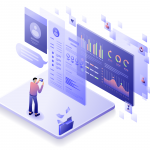Being part of the IT leadership in an organization has its advantages, but it also means you have to be familiar with technical “buzzwords”.
- “Test Data Management” is one such term you might come across.
Do you know what it means and why TDM matters? And what about the available test data tools you can employ? If the answer to one or more of these questions is “no”, then this post is for you.
Let’s start by dissecting the expression into its various body parts. We’ll define each one and then reassemble the definitions. Once we’re done defining the term, we’ll get into the meat of the post by showing five existing test data tools that can help with test data management. Let’s get started!
Test Data Management: Breaking it Down
Let us break it down into its key components i.e. Test, Data & Management.
A definition of Testing.
Software testing is an investigation conducted to provide stakeholders with information about the quality of the software product or service under test. Software testing can also provide an objective, independent view of the software to allow the business to appreciate and understand the risks of software implementation. Test techniques include, but are not limited to, the process of executing a program or application with the intent of finding software bugs (errors or other defects).
A definition of Data.
Test data, unlike the sensitive data found in our production data, is any data that’s necessary for testing purposes. This includes test data for inputs, expected test data outputs, and test environment configuration details. Test data can come from a variety of sources, including production databases, synthetic data generators, and manual input.
A definition of Management
Management is the process of administering an organization, which can be a business, non-profit, or government body. This entails setting the organization’s goals and objectives and then coordinating the efforts of employees or volunteers to achieve these targets. The available resources that can be employed include financial, natural, technological, and human resources.
Bringing TDM Together
Now that we have the definitions for each word, it’s time to put all of them together to create a complete definition for “test data management.” Here it goes:
- Test Data Management (TDM) is fundamentally test data preparation. It is the process of helping you prepare test data and maintain the test data in support of software testing. The goal of TDM is to provide a test environment that is as close to production as possible, and promotes data security while still being able to accurately test the software.
This may include, but is not be limited to underlying features like:
- Test Data Profiling i.e. The Process of Discovery & Understanding your Data.
- Test Data Preparation i.e. Generation of Realistic Test Data Using Automation to Fabricate Fake / Synthetic Data.
- Test Data Security i.e. Using Production Data & Masking / Privacy Methods on the original production data. With the intent of ensuring “Personally Identifiable Information” (sensitive customer data) is removed and we prevent a data breach.
- Test Data Provisioning i.e. Rapid Snapshotting, Cloning & Provisioning of Test Data/
- Test Data Mining i.e. The ability to View and Access Valid Test Data.
- Test Data Booking i.e. the ability to reserve Test Data for your engineering purpose
Here Are 5 Test Data Management Tools for Your Review
Here are five Data Generation Tools your organization can use to improve its approach to Test Data.
BMC (Compuware) File Aid
Compuware’s Test Data Management solution offers a standardized approach to managing test data from several data sources. Test Data Management with Compuware seeks to eliminate the need for extensive training by making it easy to create, find, extract, and compare data.
The solution can load subsets of related production data while maintaining database and application relationships. Test data management can help reduce the risk of errors, improve product quality, and shorten development timelines.
Broadcom (CA) Test Data Manager
Test Data Manager by Broadcom is a powerful test data management tool that enables organizations to manage their testing data more effectively and efficiently. Test Data Manager provides users with the ability to track, manage, and visualize their testing data in a centralized repository. Test Data Manager also offers features for managing test environments, managing test cases, and generating reports.
Enov8 Test Data Manager (DCS)
Enov8 Test Data Manager, originally known as DCS (Data Compliance Suite), is a Test Data Management platform that helps you identify where data security exposures reside, rapidly remediate these risks without error and centrally validate your compliance success. The solution also comes with IT delivery accelerators to support Data DevOps (DataOps), create test data, data mining, and test data bookings.
IBM InfoSphere Optim
IBM InfoSphere Optim is a tool that manages data at the business object level while preserving the relational integrity of the data and its business context. This allows you to easily create environments that precisely reflect end-to-end test cases by mirroring conditions found in a production environment.
InfoSphere Optim also offers other features such as data masking, ensuring data security, and subsetting, which can further help you reduce the risk of data breaches when testing in non-production environments.
Informatica Test Data Management
The test data management solution from Informatica, Test Data Management, is a tool that can identify ‘sensitive data,’ subset it, mask it, and create test data. It also allows developers and testers to save and share datasets to enhance overall efficiency.
Conclusion
As previously said, there are a lot of “buzzwords” in software engineering, and that trend isn’t going to change any time soon. Some of these words are simply fads. They seem like the “latest and greatest thing.” But just as quickly as the hip kids started using them, they fall out of favor.
However, Test data management isn’t one of those fads. It’s a process that your company must master and improve if it wants to stay competitive and promote values like Data Privacy. Test Data Management is essential in the understanding of data, it impacts our IT operations & project velocity & is key to our information security protocols.
In this article, we used a divide and conquer technique to define test data management. Test data management is the process of handling test data throughout the software development life cycle. Test data management tools help organizations manage this process by providing a way to store, track, and manipulate test data. There are many different test data management and data security solutions available on the market, each with its unique features and capabilities. So have a look & choose. Each is powerful and has its nuances. Look at the capabilities of each and decide which of the “Test Data Management” features are most important to you.
Author: Mark Dwight James
This post was written by Mark Dwight James. Mark is a Data Scientist specializing in Software Engineering. His passions are sharing ideas around software development and how companies can value stream through data best practices.


